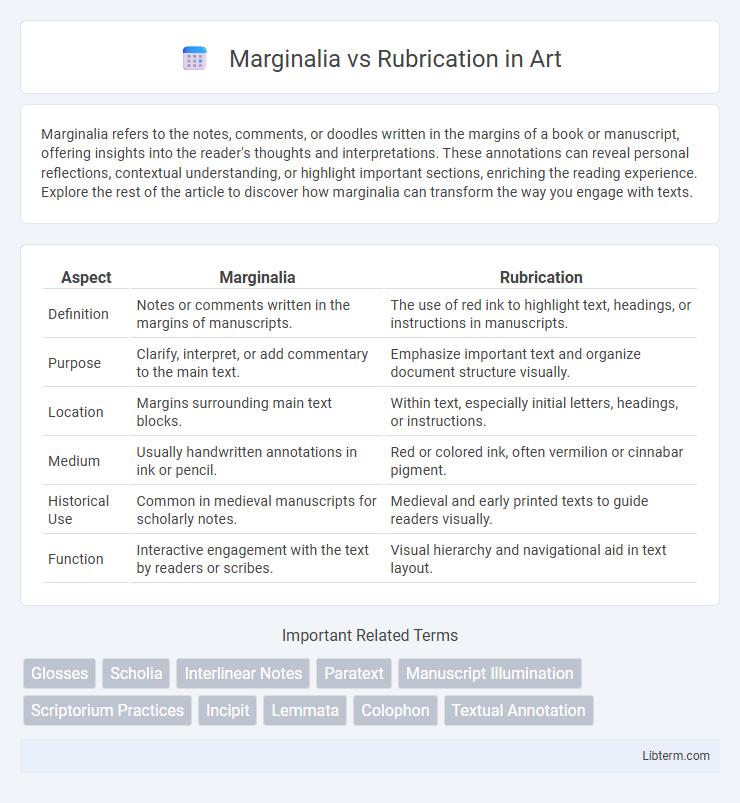Marginalia refers to the notes, comments, or doodles written in the margins of a book or manuscript, offering insights into the reader's thoughts and interpretations. These annotations can reveal personal reflections, contextual understanding, or highlight important sections, enriching the reading experience. Explore the rest of the article to discover how marginalia can transform the way you engage with texts.
Table of Comparison
| Aspect | Marginalia | Rubrication |
|---|---|---|
| Definition | Notes or comments written in the margins of manuscripts. | The use of red ink to highlight text, headings, or instructions in manuscripts. |
| Purpose | Clarify, interpret, or add commentary to the main text. | Emphasize important text and organize document structure visually. |
| Location | Margins surrounding main text blocks. | Within text, especially initial letters, headings, or instructions. |
| Medium | Usually handwritten annotations in ink or pencil. | Red or colored ink, often vermilion or cinnabar pigment. |
| Historical Use | Common in medieval manuscripts for scholarly notes. | Medieval and early printed texts to guide readers visually. |
| Function | Interactive engagement with the text by readers or scribes. | Visual hierarchy and navigational aid in text layout. |
Introduction to Marginalia and Rubrication
Marginalia refers to handwritten notes, comments, or doodles found in the margins of manuscripts or books, often providing insights or interpretations related to the main text. Rubrication involves the use of red ink to highlight headings, instructions, or important sections, serving as a visual guide for readers. Both practices originated in medieval manuscripts, enhancing readability and interaction with the text through visual and textual annotations.
Historical Origins of Marginalia
Marginalia originated in medieval manuscripts as handwritten notes, comments, and illustrations added by scribes or readers to clarify, expand, or critique the text, often reflecting scholarly engagement and personal reflection. Unlike rubrication, which involved the decorative use of red ink to highlight headings and important sections for structural organization, marginalia provided a dynamic, interactive layer of interpretation and annotation. These annotations played a crucial role in the transmission of knowledge during the Middle Ages, offering insights into contemporary thought, textual variants, and reader responses.
Evolution of Rubrication in Manuscripts
Rubrication in manuscripts evolved from simple red-ink headings to intricate color-coded organizational tools that guided reader navigation and emphasized textual hierarchy. Over centuries, rubricators incorporated decorative initials, paragraph marks, and marginal notes, enhancing both readability and aesthetic appeal. This progression contrasts with marginalia, which primarily consists of informal annotations by readers rather than systematic structural elements.
Key Differences Between Marginalia and Rubrication
Marginalia refers to handwritten notes, comments, or annotations made in the margins of a manuscript or book, often providing explanations, critiques, or personal reflections by readers or scholars. Rubrication involves the use of red ink or colored pigments to highlight headings, initials, or important text sections, serving a decorative and organizational function in medieval manuscripts and early printed books. Key differences include marginalia being primarily textual and interpretative additions made post-production, while rubrication is a pre-planned, decorative feature intended to guide reading and emphasize structure.
Functions and Purposes in Medieval Texts
Marginalia in medieval texts served as reader annotations, glosses, and interpretive notes that clarified or expanded the main text, facilitating comprehension and personal engagement with the manuscript. Rubrication functioned primarily to organize the text visually by highlighting headings, instructions, and important sections using red ink, guiding readers through sacred or legal documents efficiently. Both marginalia and rubrication enhanced textual navigation and understanding, but while marginalia offered interactive commentary, rubrication provided structural emphasis and thematic distinction.
Artistic Styles and Techniques Used
Marginalia features intricate drawings and annotations often created with fine ink lines and delicate pen work, emphasizing personal expression and detailed imagery in manuscript margins. Rubrication involves the use of red ink to highlight headings, initials, or important text, employing techniques like brush or quill application to create bold, decorative letters that enhance readability and visual hierarchy. Both styles utilize contrasting colors and precision craftsmanship, but marginalia leans more towards elaborate, whimsical illustrations while rubrication focuses on structured, ornamental text enhancements.
Influence on Reader Engagement and Interpretation
Marginalia, handwritten notes in the margins, directly engage readers by encouraging active interaction with the text, fostering deeper interpretation and personal connection. Rubrication, the use of red ink for initial letters or headings, guides reader attention and enhances comprehension through visual emphasis and structure. Both techniques shape reader engagement, with marginalia promoting critical thinking and rubrication organizing information for clearer understanding.
Marginalia and Rubrication in Religious Manuscripts
Marginalia in religious manuscripts refer to handwritten notes, annotations, or commentary placed in the margins to explain, interpret, or provide context to the main text, enhancing theological understanding. Rubrication involves the use of red ink to highlight important sections, such as titles, instructions, or liturgical cues, guiding readers through the sacred text's structure and ritual significance. Both marginalia and rubrication serve crucial roles in medieval religious manuscripts, aiding priests and scholars in navigating, interpreting, and performing religious rites accurately.
Preservation and Modern Analysis of Annotations
Marginalia and rubrication are crucial for understanding historical texts, with marginalia offering personalized insights through handwritten notes while rubrication highlights important sections using red ink. Preservation techniques emphasize careful digitization and conservation to prevent deterioration of these annotations, ensuring their accessibility for future scholarship. Modern analysis employs digital imaging and text recognition technologies to decode and interpret these markings, enhancing comprehension of manuscript context and authorial intent.
Contemporary Relevance and Digital Marginalia
Marginalia, the practice of writing notes in the margins, continues to evolve in digital formats such as e-readers and annotation software, allowing users to engage interactively with texts and share insights instantly. Rubrication, originally the addition of red ink highlights in manuscripts, influences modern design principles in digital interfaces by guiding user attention through color coding and emphasis. The contemporary relevance of marginalia lies in its role as a collaborative and personalized tool in digital learning environments, enhancing comprehension and active reading.
Marginalia Infographic

 libterm.com
libterm.com